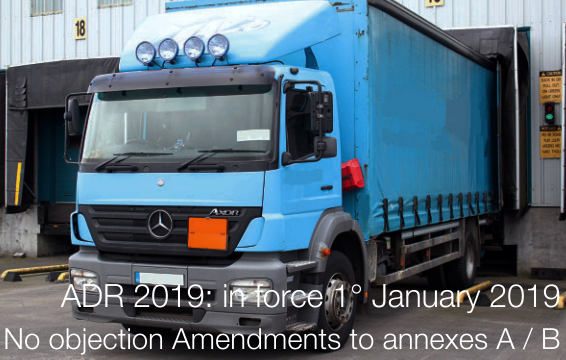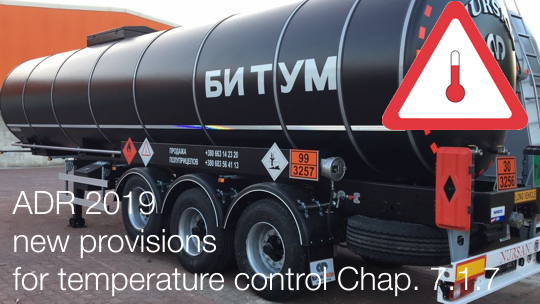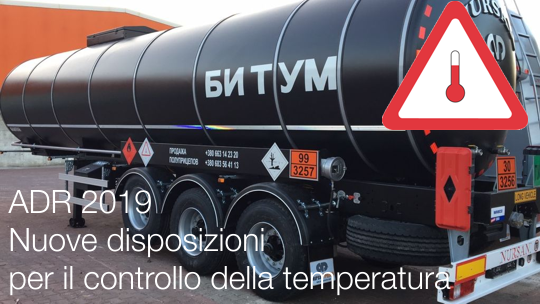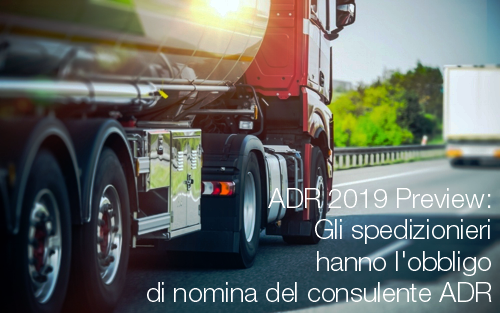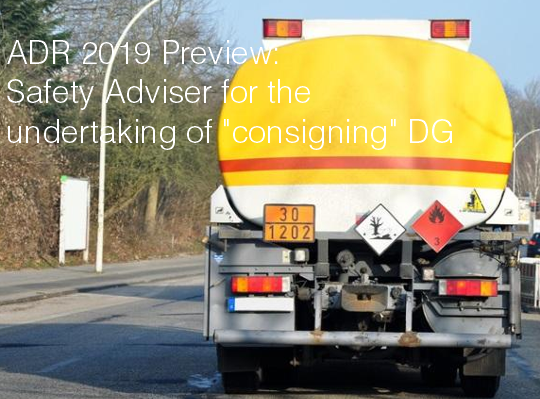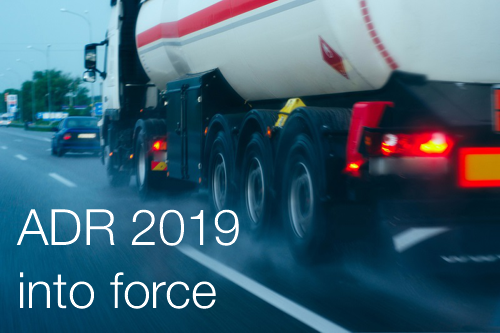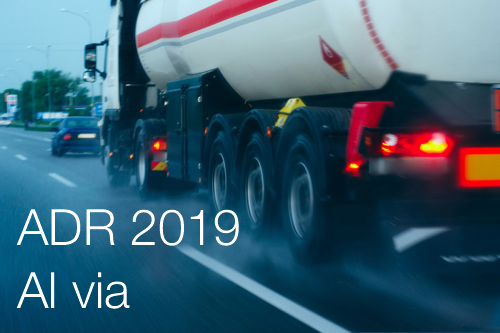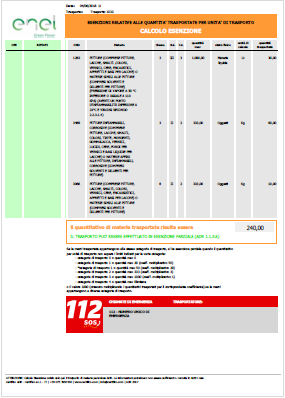
ADR 2019: 1.1.3.6 “total quantity” / “calculated value” of DG indicated in the transport document
ADR 2019
Whith ADR 2019, in the case of intended application of 1.1.3.6, the total quantity and the calculated value of dangerous goods for each transport category shall be indicated in the transport document in accordance with 1.1.3.6.3 and 1.1.3.6.4.
In Certifico ADR Manager available function “calculated value” of DG whit Report, see example Report Calculated value what can be attachment in the transport document.
Draft ADR 2017 Official
ADR 2019
______
Amendments to annexes A and B of ADR 2019
Chapter 5.4 .1.1.1
(f) Amend Note 1 to read as follows:
5.4.1.1.1
….
New ADR 2019
NOTE 1:
In the case of intended application of 1.1.3.6, the total quantity and the calculated value of dangerous goods for each transport category shall be indicated in the transport document in accordance with 1.1.3.6.3 and 1.1.3.6.4.
Currently ADR 2017
NOTE 1:
In the case of intended application of 1.1.3.6, the total quantity of dangerous goods for each transport category shall be indicated in the transport document in accordance with 1.1.3.6.3.
ADR 2019 (EN)
5.4.1.1.1.
…
NOTE 1 In the case of intended application of 1.1.3.6, the total quantity and the calculated value of dangerous goods for each transport category shall be indicated in the transport document in accordance with 1.1.3.6.3 and 1.1.3.6.4.
1.1.3.6. Exemptions related to quantities carried per transport unit
1.1.3.6.4
Where dangerous goods of different transport categories are carried in the same transport unit, the
sum of:
– The quantity of substances and articles of transport category 1 multiplied by “50”;
– The quantity of substances and articles of transport category 1 referred to in Note a to the table
in 1.1.3.6.3 multiplied by “20”;
– The quantity of substances and articles of transport category 2 multiplied by “3”; and
– The quantity of substances and articles of transport category 3;
shall not exceed “1000”.
(a) For UN Nos. 0081, 0082, 0084, 0241, 0331, 0332, 0482, 1005 and 1017, the total maximum quantity per transport unit shall be 50 kg.
Commenti ADR 2019: In IT da USTRA (CH)
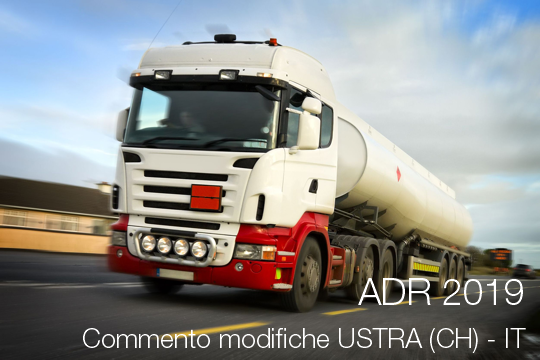
Commento modifiche ADR 2019
Pubblicato da USTRA in Italiano commernti alle modifiche dell’ADR 2019.
Lingua IT
USTRA
Ufficio federale delle strade della Svizzera
Vedi
Safety ADR© – Dangerous Goods app IT/EN | ADR 2019
Safety ADR© – Dangerous Goods ADR app IT/EN | ADR 2019
25.10.2019: Safety ADR now available DB update ADR 2019
Safety ADR© app Dangerous Goods ADR
ADR 2019 – European Agreement concerning the International Carriage of Dangerous Goods by Road.
This update version has been prepared on the basis of amendments ADR applicable as from January 1st, 2019.
Safety ADR© is an app that allows you to:
– Search the full table A cap. 3.2 ADR for UN / name / class / other* (Italian, English);
– Fill in the ADR for each subject “Substance Report” with the “Safety” parameter (1) (Italian, English);
– Fill in the ADR for each subject “Tremcards P.0″(2) (Italian, English);
– Read/Print/share/send PDF of Instructions in Writing according to ADR 5.4.2 (English, Italian, French, Russian, Danish, Latvian, Norwegian, Swedish, German, Hungarian, Romanian, Portuguese, Czech, Spanish, Turkish, Slovenian, Slovak, Estonian, Dutch (Belgium), Dutch (Netherlands), Polish, Finnish, Lithuanian, Bulgarian, Greek, Serbian);
– Get news on the home screen;
– Read/Print the ADR agreement (English, French, Russian);
– See ADR labels, classes, Kemler (Italian, English).
The completed documents, “Substance Report” and “Tremcards P.0” can be saved via e-mail in pdf format.
25.10.2018: What’s news
– [Rules] Corrigendum 1, january 3 2018 (ECE/TRANS/WP.15/237)
– [Fix] Fixed app crash when searching substances with UN Number 3492 and 3493 (English language only)
– [Fix] Substances details in tabs “Starred” and “History” not displayed correctly (fixed)
(1) Safety
The “Safety” parameter for information on the “Safety Area” (S.A.), depends on the quantity “Q” of carried goods and the code “Kemler” corrected by a “K” factor, for which it is believed that the goods to be transported duly bounded to that value in the event of an accident that could pose a risk to public health and safety (carefully read the Disclaimer).
(2) Tremcards P.0
The “Tremcards P.0” (Transport Emergency Cards – P.0) consists of 4 pages: Instruction in writing according ADR + Page “0” of Getting Started Certifico “P.0”.
The “P.0” was introduced in addition to the Instruction in writing according ADR to facilitate a better identification of the goods carried in emergency situation and as indicated in note 2 on page 3 of the Instruction in writing to add “Additional guidance”:
ADR cap. 5.4.3 Note (2) Instruction in writing: “Additional guidance shown above may be adapted to reflect the classes of dangerous goods to be carried and their means of transportation”
Price: € 9,99
In-app Products: € 23,99
Category: Productivity
Date: Oct 25, 2018
Version: iOS 1.0.5 / Android 1.0.1
Size: 64.2 MB
Languages: English, Bulgarian, Czech, Danish, Dutch, Estonian, Finnish, French, German, Greek, Hungarian, Italian, Latvian, Lithuanian, Norwegian Bokmål, Polish, Portuguese, Romanian, Russian, Serbian, Slovak, Slovenian, Spanish, Swedish, Turkish
Seller: Certifico s.r.l.
© 2004-2018 Certifico S.r.l. – Italty
info@certifico.com
+39 075 5997363
Safety and Tremcards P.0 are trademarks of Certifico S.r.l. – Italy.
*The app has only 40 materials ADR , the complete database of ADR materials is purchasable, after installation, by in-app purchase.
Safety ADR© – Dangerous Goods app IT/EN | ADR 2019
Safety ADR© – Dangerous Goods app IT/EN | ADR 2019
25.10.2018: Safety ADR è aggiornata ad ADR 2019
Safety ADR© è un’app per il trasporto di merci pericolose ADR che consente di:
– visualizzare tutta la Tabella A cap. 3.2 ADR per ONU/denominazione/classe/altro* (Italiano, Inglese);
– compilare per ciascuna materia ADR il “Report materia” con il parametro “Safety” (1) (Italiano, Inglese);
– compilare per ciascuna materia ADR la “Tremcards P.0” (2) (Italiano, Inglese);
– consultare le Istruzioni Scritte secondo l’ADR (Inglese, Italiano, Francese, Russo, Danese, Lettone, Norvegese, Svedese, Tedesco, Ungherese, Romeno, Portoghese, Ceco, Spagnolo, Turco, Sloveno, Slovacco, Estone, Neerlandese (Belgio), Neerlandese (Paesi Bassi), Polacco, Finlandese, Lituano, Bulgaro, Greco, Serbo);
– avere news in tempo reale visualizzate direttamente in Home;
– consultare l’accordo ADR (Inglese, Francese, Russo);
– consultare le etichette ADR, le classi, i Kemler (Italiano, Inglese)
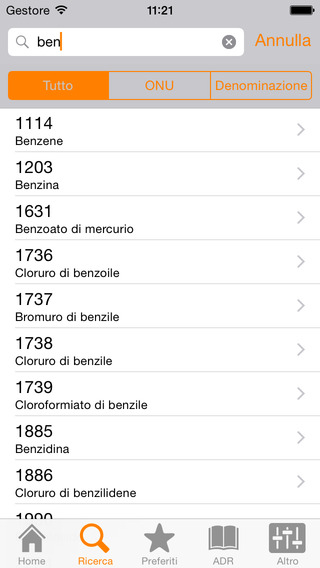
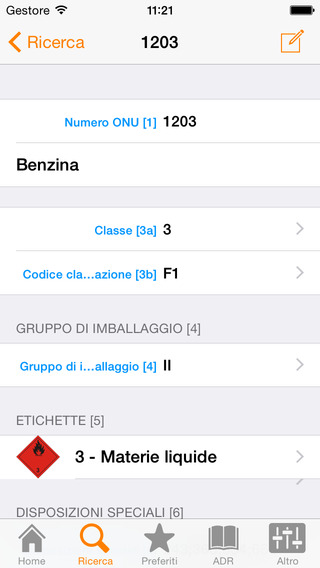
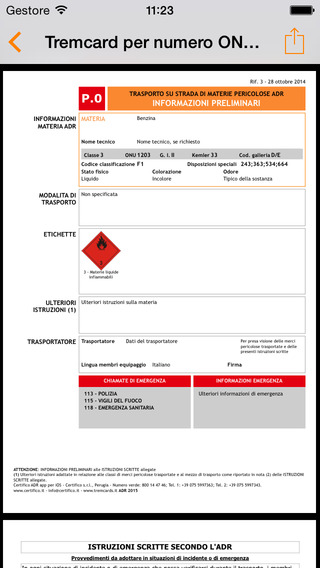
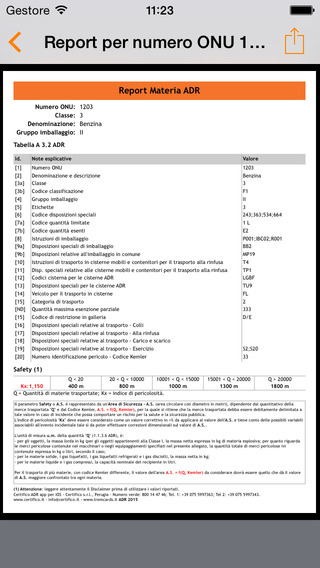
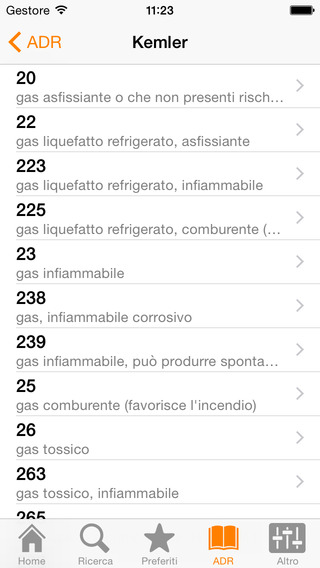
Update. 1.0.5 iOS / 1.0.1 Android
– [Normativa] ADR 2019: Aggiornamento materie ONU
– [Normativa] Emendamento 1 in vigore dal 3 gen. 2018 (ECE/TRANS/WP.15/237)
– [Fix] Crash in fase di ricerca delle materie con numero ONU 3492 e 3493 (inglese)
– [Fix] I dettagli delle materie nei tab “Preferiti” e “Cronologia” non sono visualizzati correttamente
(1) Safety
Il parametro “Safety” dà informazioni sull’Area di Sicurezza (A.S.), dipendente dal quantitativo della merce trasportata “Q” e dal codice “Kemler” corretta da un fattore “K”, per la quale si ritiene che la merce trasportata debba essere debitamente delimitata a tale valore in caso di incidente che possa comportare un rischio per la salute e la sicurezza pubblica (leggere con attenzione il Disclaimer).
(2) Tremcards P.0
La “Tremcards P.0” (Transport Emergency Cards – P.0) è formata da 4 pagine di Istruzioni Scritte ufficiali ADR + Pagina 0 di Informazioni Preliminari Certifico “P.0”.
La pagina “P.0” è stata introdotta in aggiunta alle Istruzioni Scritte ADR per facilitare una migliore individuazione delle merci trasportate in caso di emergenza e come indicato in nota 2 di pagina 3 delle Istruzioni Scritte ADR per aggiungere “Ulteriori Istruzioni”:
ADR 5.4.3 Nota (2) delle ISTRUZIONI SCRITTE:
“Le ulteriori istruzioni qui sopra indicate possono essere adattate in relazione alle classi di merci pericolose trasportate e al mezzo di trasporto.”
ADR 2017 – Accordo europeo relativo al trasporto internazionale di merci pericolose su strada.
Safety e Tremcards P.0 sono modelli depositati Certifico S.r.l. – Italia
Prezzo: € 9,99*
Acquisto database ADR 2019: € 23,99 (Acquisto in app)
Categoria: Produttività
Pubblicato: 25/10/2018
Versione: iOS 1.0.5 / Android 1.0.1
Dimensioni: 64.2
Lingue: Italiano, Inglese
Sviluppatore: Certifico s.r.l.
© 2000-2019 Certifico S.r.l.
Safety e Tremcards P.0 sono modelli depositati Certifico S.r.l. – Italia
*L’app presenta solo 40 materie ADR, il database completo delle materie ADR è acquistabile, dopo l’installazione, con l’acquisto in app.
ADR 2019: Acceptance of amendments to annexes A and B
ADR 2019 – Acceptance of amendments to annexes A and B
CN.488.2018.TREATIES-XI.B.14 of 15 October 2018 (Entry into force)
By 1 October 2018, none of the Contracting Parties to the above-mentioned Agreement had communicated an objection to the Secretary-General. Consequently, in accordance with the provisions of article 14 (3) of the Agreement, the proposed amendments to annexes A and B, as amended, shall enter into force for all Contracting Parties on 1 January 2019.
Fonte: UNECE
ADR 2019 Preview: new provisions for temperature control
ADR 2019 Preview: new provisions for temperature control Chap. 7.1.7
Attached is the new Chapter 7.1.7 “Special provisions applicable to the carriage of self-reactive substances of Class 4.1, organic peroxides of Class 5.2 and substances stabilized by temperature control” (other than self-reactive substances and organic peroxides) “.
Chapter 7.1 on General conditions for transport, loading, handling and handling that ended with Chapter 7.1.6, now, with the ADR 2019, is extended and includes the new Chapter 7.1.7, which groups general rules and special rules for temperature control. This leads to consequential changes in the provisions of parts 2, 3, 5, 8 and 9.
ADR 2019 Preview: nuove disposizioni controllo temperatura
ADR 2019 Preview: nuove disposizioni per il controllo della temperatura Cap. 7.1.7
In allegato il nuovo Cap 7.1.7 “Special provisions applicable to the carriage of self-reactive substances of Class 4.1, organic peroxides of Class 5.2 and substances stabilized by temperature control (other than self-reactive substances and organic peroxides)”.
Il Cap. 7.1 sulle Condizioni generali per il trasporto, il carico, la movimentazione e la movimentazione che terminava con il Cap. 7.1.6, ora, con l’ADR 2019, viene ampliato e include il nuovo Cap. 7.1.7, che raggruppa le regole generali e le regole speciali per il controllo della temperatura. Ciò porta a modifiche consequenziali nelle disposizioni delle parti 2, 3, 5, 8 e 9.
ADR 2019 Preview: obbligo nomina consulente ADR spedizionieri
ADR 2019 Preview: obbligo nomina consulente ADR spedizionieri
Con l’ADR 2019 l’obbligo di nomina del Consulente ADR è esteso ad ogni impresa le cui attività comprendono anche la “la spedizione” di merci pericolose su strada.
Dal draft e dal corrigendum 1 dell’ADR 2019 è stsato aggiunto, in vari punti del Cap. 1.8.3, il termine inglese “consigning” (spedizione) prima del termime “carriage” (trasporto) tra le attività obbligate alla nomina del consulente ADR.
Vedi Documento Obbligo ed Esenzione nomina Consulente ADR
In allegato documento completo EN/IT
Dalla nuova ADR 2019 EN:
___________
1.8.3 Safety Adviser1.8.3.1
Each undertaking,“the activities of which include the consigning or the carriage of dangerous goods by road, or the related packing, loading, filling or unloading”(2) shall appoint one or more safety advisers for the carriage of dangerous goods, responsible for helping to prevent the risks inherent in such activities with regard to persons, property and the environment.
1.8.3.2
The competent authorities of the Contracting Parties may provide that these requirements shall not apply to undertakings:
(a) The activities of which concern quantities in each transport unit “not exceeding those”(1) referred to in 1.1.3.6, 1.7.1.4 and in Chapters 3.3, 3.4 and 3.5; or
(b) The main or secondary activities of which are not the carriage or the related packing, filling, loading or unloading of dangerous goods but which occasionally engage in the national carriage or the related packing, filling, loading or unloading of dangerous goods posing little danger or risk of pollution.
1.8.3.3
The main task of the adviser shall be, under the responsibility of the head of the undertaking, to seek by all appropriate means and by all appropriate action, within the limits of the relevant activities of that undertaking, to facilitate the conduct of those activities in accordance with the requirements applicable and in the safest possible way.
With regard to the undertaking’s activities, the adviser has the following duties in particular:
– monitoring compliance with the requirements governing the carriage of dangerous goods;
– advising his undertaking on the carriage of dangerous goods;
– preparing an annual report to the management of his undertaking or a local public authority, as appropriate, on the undertaking’s activities in the carriage of dangerous goods. Such annual reports shall be preserved for five years and made available to the national authorities at their request.
The adviser’s duties also include monitoring the following practices and procedures relating to the relevant activities of the undertaking:
– the procedures for compliance with the requirements governing the identification of dangerous goods being transported;
– the undertaking’s practice in taking account, when purchasing means of transport, of any special requirements in connection with the dangerous goods being transported;
– the procedures for checking the equipment used in connection with the carriage, packing, filling, loading or unloading of dangerous goods;
– the proper training of the undertaking’s employees, including on the changes to the regulations, and the maintenance of records of such training;
– the implementation of proper emergency procedures in the event of any accident or incident that may affect safety during the carriage, packing, filling, loading or unloading of dangerous goods;
– investigating and, where appropriate, preparing reports on serious accidents, incidents or serious infringements recorded during the carriage, packing, filling, loading or unloading of dangerous goods;
– the implementation of appropriate measures to avoid the recurrence of accidents, incidents or serious infringements;
– the account taken of the legal prescriptions and special requirements associated with the carriage of dangerous goods in the choice and use of sub-contractors or third parties;
– verification that employees involved in the “consigning,” (1) carriage, packing, filling, loading or unloading of dangerous goods have detailed operational procedures and instructions;
– the introduction of measures to increase awareness of the risks inherent in the carriage, packing, filling, loading and unloading of dangerous goods;
– the implementation of verification procedures to ensure the presence on board the means of transport of the documents and safety equipment which must accompany transport and the compliance of such documents and equipment with the regulations;
– the implementation of verification procedures to ensure compliance with the requirements governing packing, filling, loading and unloading;
– the existence of the security plan indicated in 1.10.3.2.
ADR 2019 Preview: Safety Adviser for the undertaking of consigning DG
ADR 2019 Preview: Safety Adviser for the undertaking of consigning DG
ADR 2019
…
1.8.3 Safety Adviser
1.8.3.1
Each undertaking,“the activities of which include the consigning or the carriage of dangerous goods by road, or the related packing, loading, filling or unloading”(2) shall appoint one or more safety advisers for the carriage of dangerous goods, responsible for helping to prevent the risks inherent in such activities with regard to persons, property and the environment.
1.8.3.2
The competent authorities of the Contracting Parties may provide that these requirements shall not apply to undertakings:
(a) The activities of which concern quantities in each transport unit “not exceeding those”(1) referred to in 1.1.3.6, 1.7.1.4 and in Chapters 3.3, 3.4 and 3.5; or
(b) The main or secondary activities of which are not the carriage or the related packing, filling, loading or unloading of dangerous goods but which occasionally engage in the national carriage or the related packing, filling, loading or unloading of dangerous goods posing little danger or risk of pollution.
1.8.3.3
The main task of the adviser shall be, under the responsibility of the head of the undertaking, to seek by all appropriate means and by all appropriate action, within the limits of the relevant activities of that undertaking, to facilitate the conduct of those activities in accordance with the requirements applicable and in the safest possible way.
With regard to the undertaking’s activities, the adviser has the following duties in particular:
– monitoring compliance with the requirements governing the carriage of dangerous goods;
– advising his undertaking on the carriage of dangerous goods;
– preparing an annual report to the management of his undertaking or a local public authority, as appropriate, on the undertaking’s activities in the carriage of dangerous goods. Such annual reports shall be preserved for five years and made available to the national authorities at their request.
The adviser’s duties also include monitoring the following practices and procedures relating to the relevant activities of the undertaking:
– the procedures for compliance with the requirements governing the identification of dangerous goods being transported;
– the undertaking’s practice in taking account, when purchasing means of transport, of any special requirements in connection with the dangerous goods being transported;
– the procedures for checking the equipment used in connection with the carriage, packing, filling, loading or unloading of dangerous goods;
– the proper training of the undertaking’s employees, including on the changes to the regulations, and the maintenance of records of such training;
– the implementation of proper emergency procedures in the event of any accident or incident that may affect safety during the carriage, packing, filling, loading or unloading of dangerous goods;
– investigating and, where appropriate, preparing reports on serious accidents, incidents or serious infringements recorded during the carriage, packing, filling, loading or unloading of dangerous goods;
– the implementation of appropriate measures to avoid the recurrence of accidents, incidents or serious infringements;
– the account taken of the legal prescriptions and special requirements associated with the carriage of dangerous goods in the choice and use of sub-contractors or third parties;
– verification that employees involved in the “consigning,” (1) carriage, packing, filling, loading or unloading of dangerous goods have detailed operational procedures and instructions;
– the introduction of measures to increase awareness of the risks inherent in the carriage, packing, filling, loading and unloading of dangerous goods;
– the implementation of verification procedures to ensure the presence on board the means of transport of the documents and safety equipment which must accompany transport and the compliance of such documents and equipment with the regulations;
– the implementation of verification procedures to ensure compliance with the requirements governing packing, filling, loading and unloading;
– the existence of the security plan indicated in 1.10.3.2.
(1) Draft ADR 2019
(2) Corrigendum 1 ADR 2019
ADR 2019: procedure into force 1° January 2019
ADR 2019: procedure into force 1° January 2019
The Secretary-General of the United Nations, acting in his capacity as depositary, communicates the following:
The Government of Portugal, in accordance with paragraph 1 of article 14 of the above Agreement, has transmitted to the Secretary-General the text of the proposed amendments to Annexes A and B, as amended, to the above Agreement. It will be recalled that the text of these proposed amendments had been approved by the Working Party on the Transport of Dangerous Goods of the Economic Commission for Europe at its 100th, 101st, 102nd, 103rd and 104th sessions.
The procedure for the amendment of annexes to the Agreement is set forth in its article 14, in particular, in paragraphs 2 and 3, which read as follows:
“2. The Secretary-General shall transmit any proposal made under paragraph 1 of this article to all Contracting Parties and inform thereof the other countries referred to in article 6, paragraph 1.
3. Any proposed amendment to the annexes shall be deemed to be accepted unless, within three months from the date on which the Secretary-General circulates it, at least one-third of the Contracting Parties, or five of them if one-third exceeds that figure, have given the Secretary-General written notification of their objection to the proposed amendment.
If the amendment is deemed to be accepted, it shall enter into force for all the Contracting Parties, either on the expiry of a further period of three months or, in cases where similar amendments have been or are likely to be made to the other international agreements referred to in paragraph 1 of this article, on the expiry of a period the duration of which shall be determined by the Secretary-General in such a way as to allow, wherever possible, the simultaneous entry into force of the amendment and those that have been or are likely to be made to such other agreements; such period shall not, however, be of less than one month’s duration.”
Consequently, unless the proposed amendments to the Annexes are deemed rejected pursuant to article 14 (3) within three months from the date of the notification, i.e., on 1 October 2018, the amendments in question will enter into force on 1 January 2019.
The texts of the proposed amendments are contained in the following documents:
– ECE/TRANS/WP.15/240,
– ECE/TRANS/WP.15/240/Corr.1
– ECE/TRANS/WP.15/240/Add.1,
which can be accessed on the website of the Transport Division of the Economic Commission for Europe at
the following address:
ADR 2019: al via l’approvazione con la Comunicazione UNECE
ADR 2019: al via la procedura di approvazione con la comunicazione UNECE
Come da procedura (Art. 14 paragrafo 1 ADR), il Segretario Generale dell’ONU ha comunicato in data 1° Luglio 2018 con nota C.N.304.2018.TREATIES-XI.B.14, di aver ricevuto dal Portogallo (Chairman del WP.15), il testo degli emendamenti all’ADR che dovranno entrare in vigore il 1° gennaio 2019.
Se entro tre mesi (entro il 1° ottobre 2018) non vi saranno obiezioni da parte degli Stati contraenti tale testo risulterà definitivamente approvato.
Normativa quadro Merci Pericolose | Consolidato 2018
Normativa quadro Merci Pericolose | Consolidato 2018
Il testo “Normativa quadro Merci Pericolose”, consolida i testi della Direttiva 2008/68/CE del Parlamento Europeo e del Consiglio del 24 settembre 2008 relativa al trasporto interno di merci pericolose (Direttiva quadro merci pericolose) e del Decreto Legislativo 27 gennaio 2010, n. 35 Attuazione della direttiva 2008/68/CE, relativa al trasporto interno di merci pericolose, con le modifiche dal 2009 al 2018.
Ed. 1.0 del 15 Maggio 2018.
Disponibile, in allegato, il testo consolidato Riservato Abbonati in formato PDF stampabile/copiabile.
Download Indice Ed. 1.0 del 15 Maggio 2018
______
La direttiva 2008/68/CE è la Direttiva quadro dell’UE per il trasporto di merci pericolose:
– su strada | ADR
– su ferrovia | RID
– per via navigabile interna | ADN
….
Ed. 1.0 2018 Normativa quadro Merci Pericolose | Consolidato 2018
Direttiva 2008/68/CE
del Parlamento Europeo e del Consiglio del 24 settembre 2008 relativa al trasporto interno di merci pericolose (GUUE L 260 del 30.9.2008, pag. 13)
Il testo consolidato della Direttiva 2008/68/CE tiene conto delle modifiche intervenute dal 2009 al 2018:
Decisione 2009/240/CE della Commissione del 4 marzo 2009
Decisione 2010/187/UE della Commissione del 25 marzo 2010
Direttiva 2010/61/UE della Commissione del 2 settembre 2010
Decisione 2011/26/UE della Commissione del 14 gennaio 2011
Decisione di esecuzione 2012/188/UE della Commissione del 4 aprile 2012
Direttiva 2012/45/UE della Commissione del 3 dicembre 2012
Decisione di esecuzione 2013/218/UE della Commissione del 6 maggio 2013
Direttiva 2014/103/UE della Commissione del 21 novembre 2014
Decisione di esecuzione (UE) 2015/217 della Commissione del 10 aprile 2014
Decisione di esecuzione (UE) 2015/974 della Commissione del 17 giugno 2015
Decisione di esecuzione (UE) 2016/629 della Commissione del 20 aprile 2016
Direttiva (UE) 2016/2309 della Commissione del 16 dicembre 2016
Decisione di esecuzione (UE) 2017/695 della Commissione del 7 aprile 2017
Direttiva (UE) 2018/217 della Commissione del 31 gennaio 2018
Attuazione della direttiva 2008/68/CE, relativa al trasporto interno di merci pericolose. (G.U. n. 58 dell’ 11.03.2010)
Decreto 16 gennaio 2015 (G.U. n.78 03/04/2015)Decreto 12 maggio 2017 (G.U. n.139 17/06/2017)
…
Formato: pdf
Pagine: +65
Edizione: 1.0
Pubblicato: 15/05/2018
Autore: Ing. Marco Maccarelli
Editore: Certifico s.r.l.
Lingue: Italiano
ISBN: 978-88-98550-746
Abbonati: Abbonati Trasporto ADR/3X/4X/Full



